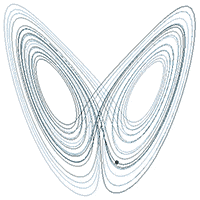We are all familiar with the concepts of 2 dimensional graphs with an x and y axis. It is not too difficult to understand how we might add a third and have a z axis. On such graphs a point represents a combination of 2 or 3 parameters (x,y) or (x,y,z). For orthogonal variables of equal scale we can use an analogy of distance between points in that the distance is √(x2 + y2 + z2). As such we can refer to any set of parameters where this relationship is expected to exist using the concept of “space”. This concept can be extended beyond three dimensions to 4, 5 or even much higher.
A digital model of the atmosphere consists of a large array cells. Each cell contains a set of parameters. If these are linear and can be scaled, then they can be represented by a distance. For n cells, each with m parameters, these can be represented by n.m dimensional space, and the set of parameters characterising the atmosphere can be plotted as a point in n.m space.
When an ensemble forecast is run using a ray of initial values, these initial values correspond to a set of points in the n.m space and in order to explore this space they are chosen to be widely dispersed.
The butterfly effect
 The butterfly effect is a phenomenon whereby small perturbations in the atmosphere tend to grow to become larger and larger. This means that if we go back far enough, these perturbations will be so small that they are smaller than the highest precision that can be reasonably used in a model. These perturbations are represented in n.m space by points, but just as phenomenon like the flap of a butterfly’s wings can grow in the atmosphere, so within n.m space, starting conditions that are so close together that they cannot be distinguished tend to grow to expand more and more space.
The butterfly effect is a phenomenon whereby small perturbations in the atmosphere tend to grow to become larger and larger. This means that if we go back far enough, these perturbations will be so small that they are smaller than the highest precision that can be reasonably used in a model. These perturbations are represented in n.m space by points, but just as phenomenon like the flap of a butterfly’s wings can grow in the atmosphere, so within n.m space, starting conditions that are so close together that they cannot be distinguished tend to grow to expand more and more space.
However, because n.m.space is constrained by what is physically possible, if some parts of the space being to expand, then other parts must shrink.
 The effect is that whilst the initial set of conditions of a ensemble forecast may be reasonable well spaced in n.m space, as small areas of the space expand due to the butterfly effect, the space occupied by the initial perturbations destroys and no longer becomes evenly spread. The result, is that fairly quickly the initial perturbations are no longer exploring a well spread area of n.m.space but are instead bunched and at the extreme they become denser and denser areas leaving large unexplored areas of potential futures.
The effect is that whilst the initial set of conditions of a ensemble forecast may be reasonable well spaced in n.m space, as small areas of the space expand due to the butterfly effect, the space occupied by the initial perturbations destroys and no longer becomes evenly spread. The result, is that fairly quickly the initial perturbations are no longer exploring a well spread area of n.m.space but are instead bunched and at the extreme they become denser and denser areas leaving large unexplored areas of potential futures.
Thus in order to explore new spaces that open up, it is necessary to have a mechanism to redistribute the model points in n.m space.
One mechanism, is to add small perturbations – in the manner that a molecule in a heated gas is constantly knocked out – so that the ensemble forecast points tend to redistrubute themselves more evenly in n.m space.

